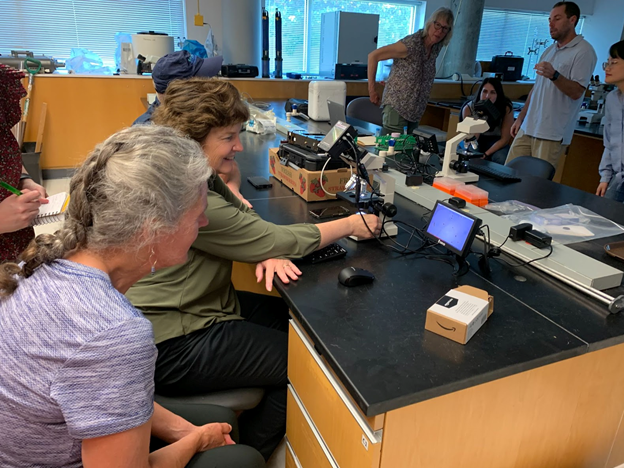
Dr. Margaret Mulholland from Old Dominion University (left) and Dr. Kim Reece from the Virginia Institute of Marine Science (center, at microscope) test the HABscope system during last month’s training. Credit: Michelle Tomlinson, NCCOS.
HABscope, the portable microscope system that uses video and artificial intelligence to quickly analyze Gulf of Mexico water samples for red tide (Karenia brevis), is now being deployed in other regions to detect other species of harmful algae.
Last month, NCCOS staff trained researchers from the Virginia Institute of Marine Science and Old Dominion University to use the system to detect and count cells of Alexandrium monilatum, which can kill fish and reduce growth of shellfish larvae vital to Chesapeake Bay and its economy. The trainees will use the HABscope data, along with satellite imagery, to develop predictive models that could ultimately inform a harmful algal bloom (HAB) forecast for the bay.
In the Gulf of Mexico, near-annual blooms of Karenia brevis adversely affect human and animal health and cause significant economic losses. Beach and fishery closures, reductions in tourism, and medical interventions result in the loss of millions of dollars per outbreak. Having timely, accurate information about red tides can help minimize these impacts.
Cell counts for Karenia brevis samples are typically completed manually by a technician in a lab using a laboratory-grade microscope. The counts can take up to a week to complete, and, at the height of the bloom season, are unlikely to be valid when published. In response, NCCOS and partners developed HABscope for use by volunteers with minimal training and to provide real-time cell counts in the field.
The HABscope field kit includes a classroom-grade, portable microscope outfitted with an adaptor to mount an Apple iPOD Touch to the eyepiece, and a power supply. Special software on the iPOD Touch allows users to record videos of water samples and upload the videos to a cloud server for analysis. The server runs an algorithm that detects and counts algal cells in the videos based on species-specific cell size and motility patterns. The entire system costs around $400.
With funding from NCCOS's Monitoring and Event Response for Harmful Algal Blooms (MERHAB) Program, citizen science groups in the Gulf of Mexico have been providing their volunteers with HABscopes. For the last several years, these volunteers have been using the HABscopes to strengthen the region's existing HAB monitoring and forecasting networks with real-time data.
 Official websites use .gov
A .gov website belongs to an official government organization in the United States.
Official websites use .gov
A .gov website belongs to an official government organization in the United States. Secure .gov websites use HTTPS
A lock or https:// means you’ve safely connected to the .gov website. Share sensitive information only on official, secure websites.
Secure .gov websites use HTTPS
A lock or https:// means you’ve safely connected to the .gov website. Share sensitive information only on official, secure websites.